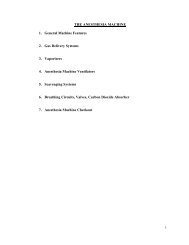BUMC Basics.pdf - Anesthesia Home
BUMC Basics.pdf - Anesthesia Home
BUMC Basics.pdf - Anesthesia Home
You also want an ePaper? Increase the reach of your titles
YUMPU automatically turns print PDFs into web optimized ePapers that Google loves.
102<br />
3. Calculate anion gap by Na- Cl- HCO3 (nl 8-12; if albumin<br />
is low reduce normal range by 2-3 for each 1 gm reduction<br />
of albumin below normal):<br />
Causes of AGMA: KUSMALE (ketones, uremia,<br />
salicylates, methanol, paraldehyde, lactic acidosis, or<br />
ethylene glycol) or GOLDMARK-paper submitted by<br />
Mehta et al (glycols, oxyproline, L-lactate, D-lactate,<br />
Methanol, Aspirin, Renal, Ketoacidosis)<br />
If anion gap, consider the following: urine and serum<br />
ketones, renal function, lactate, Utox, plasma osmolal gap.<br />
Osmolal gap: “Delta Osmoles” =measured plasma<br />
osmolality - calculated osmolality<br />
Calculated osmolality = (2xNa)+(glucose/18)+(BUN/2.8)<br />
Osmolal gap >15 suggests methanol or ethylene glycol<br />
If anion gap is decreased, you should suspect a<br />
decreased albumin or disorders that increase<br />
“unmeasured” cations such as multiple myeloma, extreme<br />
hypercalcemia, hypermagnesemia, lithium.<br />
4. If there is a high anion gap, then calculate how much it is<br />
increased above the normal range (ie, Anion Gap Increase<br />
= observed anion gap-expected anion gap (8 - 12 if<br />
albumin is normal)<br />
Increase in Gap + measured HCO3 should = about 24<br />
(The gap should go up about the same amount the HCO3<br />
goes down)<br />
• If this is >24 consider concomitant metabolic<br />
alkalosis or severe chronic respiratory acidosis<br />
• If this is




